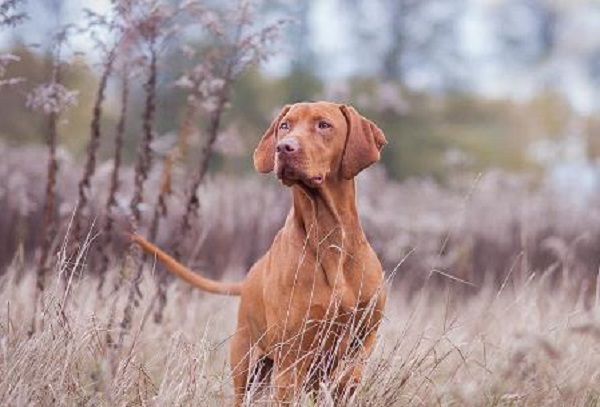Explore the world of Vizsla dogs with us as we unveil their distinctive characteristics and share essential care tips. Originating from Hungary, these medium-sized companions with a russet coat have a rich history in versatile hunting. Often mistaken for pointers or Weimaraners, Vizslas are cherished for their affectionate nature. Before bringing one home, dive into this concise guide for insights into their traits and proper care techniques.

Quick information about Vizsla dogs
- Origin: Hungary
- Size: Medium
- Breed Group: Sporting
- Lifespan: 10-15 years
- Coat: Short, smooth, dense, solid golden rust color
- Temperament: Friendly, intelligent, active
- Exercise Needs: High
- Training Needs: Easy to train
- Health Concerns: Generally healthy, prone to conditions like hip dysplasia, elbow dysplasia, eye problems, and allergies
- Noteworthy Trait: Impressive speed, reaching nearly 40mph; showcasing agility and athleticism.
History of the Vizsla
The history of the Vizslas is steeped in a noble and old lineage that dates back to Hungary in the eighth century. These canines, which were first created by the Magyar tribes, were necessary for hunting and needed to possess qualities like bravery, athleticism, speed, and stamina. Called the Magyar or Hungarian Vizsla, the importance of this breed is highlighted by 10th-century stone etchings that show a Magyar tribesman with a dog that looks like a Vizsla.
Vizslas developed into cherished companions of Hungarian nobles throughout the years. The popular Vizsla of today won over many people’s hearts as a result of the breed’s development of improved temperament and hunting abilities.
The Vizsla was in danger of becoming extinct because to a severe population fall in the late 19th century. But the commitment of breed lovers saved these dogs from extinction, which resulted in a rise in demand.
The American Kennel Club (AKC) officially recognized Vizslas as a breed in 1960, after they were first brought to the country in the middle of the 20th century. As a testament to its historical importance and ongoing appeal as adaptable and loving companions, vizslas are still a popular breed in North America and Europe today.
The Vizsla’s characteristics

The Vizsla is characterized by its exceptional companionship, often earning the moniker “Velcro dogs” for their strong bonds with family members. These outgoing and friendly dogs form attachments to both individuals and the entire family. While sociable with people, other dogs, and cats, their affectionate nature may lead to separation anxiety if left alone for extended periods. Ideally suited to households where companionship is readily available throughout the day, the Vizsla thrives on the close connections it forms with its human family.
About appearance
The Vizsla is an elegant and athletic breed with a distinct appearance. These dogs are of medium size, featuring a well-muscled and proportionate build. Their short, smooth coat comes in a lustrous golden rust color, contributing to their striking appearance.
Notable for their expressive eyes and long, pendulous ears, Vizslas possess a refined and alert facial expression. Their nose is typically brown, complementing the warm tones of their coat. The breed’s tail is traditionally docked to a medium length, adding to the overall balanced and graceful appearance.
Vizslas exude an aura of energy and athleticism, embodying a harmonious blend of strength and agility. Their overall appearance reflects the breed’s history as a hunting and companion dog, showcasing a combination of elegance, functionality, and a friendly demeanor.
Personality
The Vizsla has a lovely personality that combines tenderness, compassion, and vitality. They are well known for their superior learning capacity and their high social affinity. While typically obedient, individual variances occur, and some Vizslas may demonstrate qualities like stubbornness, hyperactivity, or shyness. Their athletic and gregarious temperament need care to avoid damaging behavior brought on by boredom. But with proper training, consistent exercise, and company, the Vizsla becomes an incredibly obedient and amazing canine friend.
Most importantly, Vizsla socializing must begin early. A well-rounded and adaptive adult dog is a result of the experiences, sights, noises, and people they were exposed to as young dogs.
Size
This breed is distinguished by its medium size and thin frame; males normally measure 22 to 24 inches at the shoulder, while females measure somewhat less at 21 to 23 inches. These dogs weigh between 45 and 65 pounds; females are typically smaller than males.
Care Vizsla
The Vizsla is well known for having a strong activity level, a loving temperament, and flexibility. Given that it needs frequent exercise, families that encourage an active outdoor lifestyle, like as hiking, are the greatest candidates for this breed. Frequent exercise is required to prevent their limitless energy from deteriorating into boredom and maybe becoming deadly inside. They also have a reputation for being excellent chewers, so it’s important to offer them a variety of engaging and safe toys to keep them occupied.
Diet and Nutrition
Like all dogs, it’s important to provide your Vizsla with a high-quality and appropriately portion-controlled diet.
Vizslas, known for their deep chests, are more susceptible to the serious condition known as bloat. To minimize the risk, it is advisable to feed them at least twice a day rather than one large meal. Additionally, if they tend to eat quickly, using a slow feeder or interactive treat toy can encourage slower consumption and reduce the likelihood of bloat.
Grooming
Grooming the Vizsla is a straightforward and low-maintenance task. With their short coat, a weekly brushing is generally sufficient to remove dead hair and keep their coat in good condition. Fortunately, Vizslas are not prone to excessive shedding, adding to the ease of grooming tasks.
In addition to brushing, regular checks on ears, eyes, teeth, and nails are essential for overall health maintenance. Cleaning ears to prevent wax buildup, ensuring eyes are clear and free from discharge, regular dental care, and trimming nails when needed are part of the routine grooming care for a Vizsla.
Exercise
For Vizslas, a breed known for its agility and success in competitive sports, exercise is essential. Their love of water provides an additional element to their physical activities, and their natural hunting, pointing, and retrieving talents make them ideal for scent work trials.
Notably, Vizslas are distinguished for their remarkable agility and endurance. Owners often emphasize that their dogs need long runs in the outdoors every day and that a little stroll won’t cut it when it comes to their exercise needs. Because of their high levels of energy and love of running, the breed is well-liked for sports like Canicross, where they may compete in running alongside their owners. Providing for a Vizsla’s exercise demands is not simply a habit; it’s essential to their general health and happiness.
Training
Because Vizslas are intelligent and eager to please, training them is a rewarding experience. Positive training approaches are effective, and these dogs pick up instructions fast. They are suited for jobs like emotional assistance or hunting since they like what they do. Because alert barking is a communication activity, calm conduct has to be consistently reinforced in order to address it. Leveraging their intellect and providing positive reinforcement for a well-mannered and satisfied companion are key components of successful training.
Can a Vizsla get along with other animals?

Vizslas are wonderful companions for kids since they are often affectionate and gregarious. However, children younger than six may find their energy too much to handle. Teaching kids how to approach and engage with dogs is crucial, as is watching over any encounters to avoid any possible problems.
Regarding other animals, Vizslas usually get along well with other dogs and may even become friends with cats if they grow up together. But when it comes to smaller pets, like birds, care should be taken since their innate hunting instincts may kick in. It is advised against putting your faith in a Vizsla when it comes to tiny creatures like gerbils, hamsters, or rabbits.
To guarantee happy and secure interactions when a Vizsla is introduced to other animals, supervision and appropriate introduction are essential.
Common health problems of Vizsla
Although vizslas are a generally healthy breed, they may, like many other breeds, be susceptible to certain hereditary health issues. Although a trustworthy breeder carrying out health examinations might lower risks, the following are some typical health issues linked to Vizslas:
- Canine epilepsy: Compared to other breeds, vizslas are more likely to have epilepsy-related seizures. Although there isn’t a treatment, research is still being done to find the best ways to manage the condition using medicine and lifestyle changes.
- Autoimmune Disorders: Vizslas are more prone to autoimmune disorders, including as food and seasonal allergies. Vizsla inflammatory polymyopathy is a breed-specific illness that is being studied and, if detected early enough, may be treated with immunosuppressants.
- Hip dysplasia: Is a common disorder characterized by improper development of the hip joint, which in severe instances may need surgical intervention.
- Bloat, also known as gastric dilatation-volvulus, or GDV: Vizslas may be susceptible to this potentially fatal illness in which the stomach dilates and twists. It is essential to get immediate veterinarian care.
Vizsla lifespan
The average lifespan of a Vizsla typically ranges between 10 to 14 years. As with any dog, individual factors such as genetics, overall health, diet, and lifestyle can influence the lifespan. Providing proper veterinary care, a balanced diet, regular exercise, and a loving environment can contribute to a Vizsla’s longevity. Responsible breeding practices that prioritize health and genetic diversity can also play a role in promoting a longer and healthier life for these dogs.
Vizsla purchase price

Purchasing a Vizsla from a breeder might run you anywhere between $500 and $1,700. It’s important to do extensive research and choose a reliable breeder that lets prospective purchasers visit and see the pups with their mother in a loving household. Puppies should not be released to their new homes until they are at least eight weeks old, according to responsible breeders. This guarantees that purchasers get a Vizsla that has been socialized and properly cared for before to joining a new home.
The benefits and drawbacks of Vizsla dogs
| Pros of Vizsla Dogs | Cons of Vizsla Dogs |
| Well-suited for Active Lifestyles | High Energy Levels |
| Affectionate Nature | Not Suited to Loneliness |
| Intelligent and Eager to Please | Proneness to Chewing and Barking |
More Info For You
Conclusion
Vizsla dogs bring a delightful combination of affection, intelligence, and energy to households. Their suitability for active lifestyles and loyalty make them wonderful companions. However, prospective owners should be mindful of their high energy levels, need for constant stimulation, and tendency for separation anxiety. Proper care, including regular exercise, positive training, and attention to their social nature, ensures a harmonious relationship with these loving and lively canine companions.
